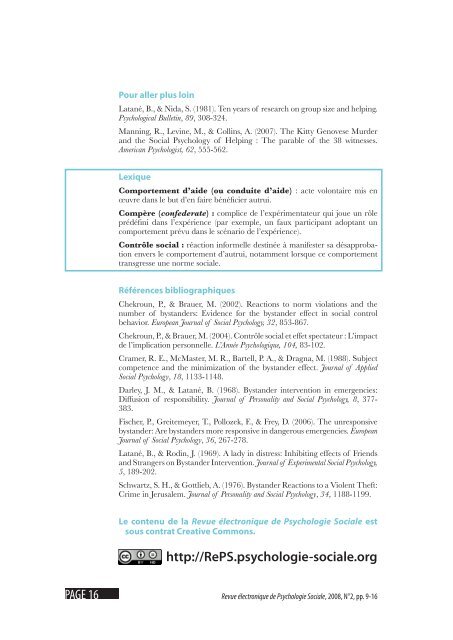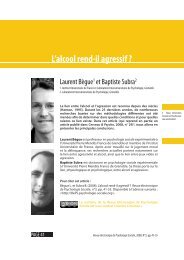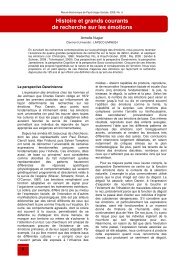Pourquoi les individus aident-ils moins autrui lorsqu'ils sont nombreux
Pourquoi les individus aident-ils moins autrui lorsqu'ils sont nombreux
Pourquoi les individus aident-ils moins autrui lorsqu'ils sont nombreux
You also want an ePaper? Increase the reach of your titles
YUMPU automatically turns print PDFs into web optimized ePapers that Google loves.
PAGE 16<br />
Pour aller plus loin<br />
Latané, B., & Nida, S. (1981). Ten years of research on group size and helping.<br />
Psychological Bulletin, 89, 308-324.<br />
Manning, R., Levine, M., & Collins, A. (2007). The Kitty Genovese Murder<br />
and the Social Psychology of Helping : The parable of the 38 witnesses.<br />
American Psychologist, 62, 555-562.<br />
Lexique<br />
Comportement d’aide (ou conduite d’aide) : acte volontaire mis en<br />
œuvre dans le but d’en faire bénéficier <strong>autrui</strong>.<br />
Compère (confederate) : complice de l’expérimentateur qui joue un rôle<br />
prédéfini dans l’expérience (par exemple, un faux participant adoptant un<br />
comportement prévu dans le scénario de l’expérience).<br />
Contrôle social : réaction informelle destinée à manifester sa désapprobation<br />
envers le comportement d’<strong>autrui</strong>, notamment lorsque ce comportement<br />
transgresse une norme sociale.<br />
Références bibliographiques<br />
Chekroun, P., & Brauer, M. (2002). Reactions to norm violations and the<br />
number of bystanders: Evidence for the bystander effect in social control<br />
behavior. European Journal of Social Psychology, 32, 853-867.<br />
Chekroun, P., & Brauer, M. (2004). Contrôle social et effet spectateur : L’impact<br />
de l’implication personnelle. L’Année Psychologique, 104, 83-102.<br />
Cramer, R. E., McMaster, M. R., Bartell, P. A., & Dragna, M. (1988). Subject<br />
competence and the minimization of the bystander effect. Journal of Applied<br />
Social Psychology, 18, 1133-1148.<br />
Darley, J. M., & Latané, B. (1968). Bystander intervention in emergencies:<br />
Diffusion of responsibility. Journal of Personality and Social Psychology, 8, 377-<br />
383.<br />
Fischer, P., Greitemeyer, T., Pollozek, F., & Frey, D. (2006). The unresponsive<br />
bystander: Are bystanders more responsive in dangerous emergencies. European<br />
Journal of Social Psychology, 36, 267-278.<br />
Latané, B., & Rodin, J. (1969). A lady in distress: Inhibiting effects of Friends<br />
and Strangers on Bystander Intervention. Journal of Experimental Social Psychology,<br />
5, 189-202.<br />
Schwartz, S. H., & Gottlieb, A. (1976). Bystander Reactions to a Violent Theft:<br />
Crime in Jerusalem. Journal of Personality and Social Psychology, 34, 1188-1199.<br />
Le contenu de la Revue électronique de Psychologie Sociale est<br />
sous contrat Creative Commons.<br />
http://RePS.psychologie-sociale.org<br />
Revue électronique de Psychologie Sociale, 2008, N°2, pp. 9-16




